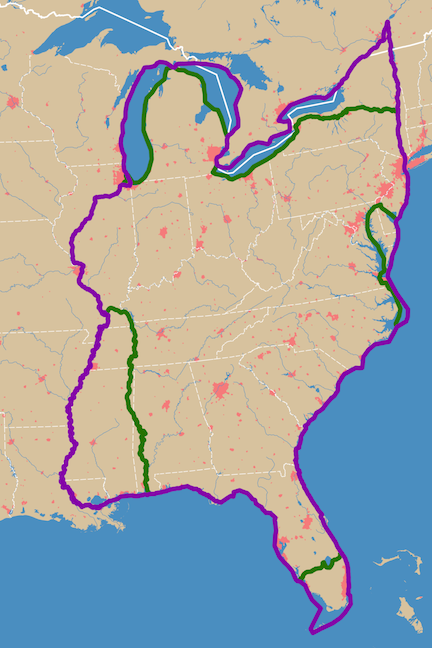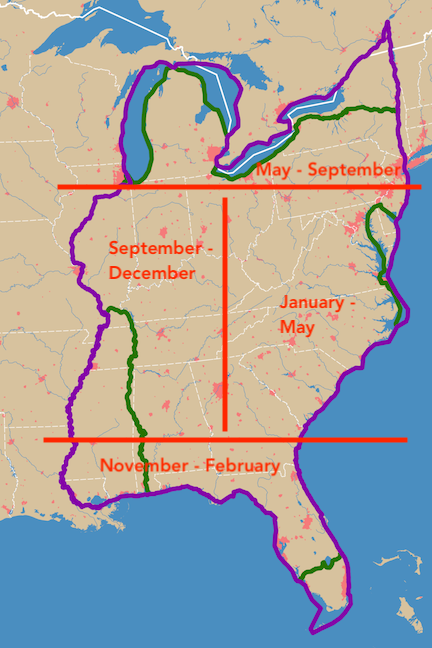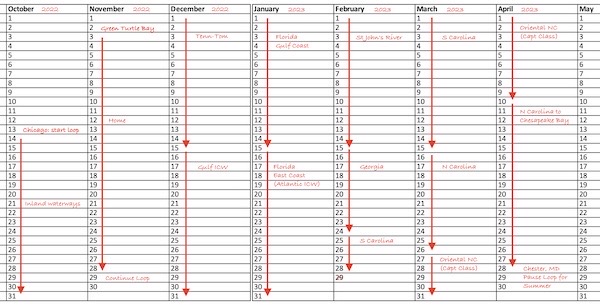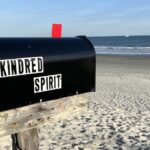In this part of the series, I explain the very important seasonal aspects of a Great Loop trip and why you need to plan to be on certain parts of the Loop at certain times of the year.

This maps offers a reasonably good illustration of the Great Loop route options. Image by Tom Fish · geo.fish · Fish Eye, Public domain, via Wikimedia Commons
The Great Loop is an extremely long voyage that normally takes about a year to complete. From Wikipedia:
The Great Loop is a system of waterways that encompasses the eastern portion of the United States and part of Canada. It is made up of both natural and man-made waterways, including the Atlantic and Gulf Intracoastal Waterways, the Great Lakes, the Erie Canal, and the Mississippi and Tennessee-Tombigbee Waterway. The entire loop stretches about 6,000 miles (9,700 km).
Keep in mind that the Loop can be longer or possibly a bit shorter depending on the route decisions you make.
Why a Year?
You’ll hear lots of folks claim that the Great Loop can be done in less than a year. This is true. But the one-year estimate is based on conditions:
- You cannot do the northern part of the Loop — specifically, the parts involving the New York or Canadian canal systems — in the winter. They close sometime in October and re-open sometime in May. Facilities along the Great Lakes are likely to be closed, too. But do you really want to be on your boat in northern New York State, Canada, or the Great Lakes in winter?
- Some insurance companies do not provide coverage to boats operating below a certain latitude during hurricane season. That might make the Gulf Intracoastal Waterway (GICW), Florida, and the southern parts of the Atlantic Intracoastal Waterway (AICW) off limits for your boat. (Oddly, my insurance does not limit me, but I’m not an idiot and don’t want to be in the south during hurricane season.)
These two limitations sort of force you into a calendar year schedule. But you can work around that if you want to finish more quickly. It’s all a matter of timing. And that’s where the planning comes in.
More than a Year? Sure! Why Not?
You can also take more than a year to do the Great Loop. That’s the situation I’m in.
If I haven’t made it clear elsewhere, I’ll make it clear here: my goal is not to “finish the Loop.” My goal is to experience cruising, using the Loop as a sort of excuse to do this. That’s why I don’t mind back-tracking and repeating parts of the trip. While I hope and expect to finish the Loop sometime in September 2024, it’s not some sort of “bucket list” item that drives me. Experiencing the journey is what drives me.
Maybe you should think about your goal as you plan.
I had to go home to work in the summer of 2023, so I missed out on the canal system season. I put my boat up on the hard in the Annapolis area for the summer and returned to it in late September. Since I couldn’t go north, I went south — all the way down to the Florida Keys. But I could have just left the boat on the hard until this spring and then got back on the boat to continue moving north. I would have missed a whole year of boating, but that would be perfectly acceptable for some folks.
Likewise, you could extend your trip by just a few months by taking a few weeks or months off along the way. (You might actually need to do that if your boat needs maintenance; I talk more about that in Part 5 of this series.) It’s actually pretty common to take a break. I took three weeks off in November 2022 and will take another four weeks off in April 2024.
Keep in mind that it is possible to take some time off and still get the Loop done in a year. Again, that’s where planning comes in.
Making that Long Term Plan
So here are my suggestions for planning your Great Loop trip:
-

In this image, I’ve taken the above map and modified it to add suggested dates for various sections of the loop. Yes, I know there’s overlap; there is some flexibility. These are my suggestions.Decide where and when you want to start the trip, keeping in mind the limitations set by seasons (no winter travel in the north) or your insurance company (no summer travel in the south). The map shown here might be helpful. For example, if you plan to start in Savanah, GA, you probably don’t want to start in October.
- Make a list of dates you know you need (or want) to be off the boat. Do you want to spend the holidays with family? Is someone getting married? Is there an expected birth? Graduation? Work or other commitment? List these things, along with the amount of time you’re expected to be off the boat. For example, back in 2022, I needed to attend two art shows and have Thanksgiving dinner in November back home. I planned to be off the boat from November 3 through November 29. These dates become especially important in Part 2 planning, but you should get them on your radar as soon as you know about them. Keep in mind that some of these dates could be for locations along the loop. Maybe you want to attend TrawlerFest in Stuart, FL, which is normally held in February. Get the date on your list, along with the location.
- Rough out a cruising plan based on the above. Keep in mind that this plan will change.
I highly recommend buying one or more monthly planners or making your own to plan this out. It’s a lot easier to see it in calendar format — at least it is for me. You don’t have to get detailed — other than known dates you’ll be away or must be somewhere specific. This will all change as you continue your regular planning process.
Example Plan from My Loop
I think it might be a useful to see an example of this first plan for my loop and how it changed. I am not suggesting that you follow my plan; this is just an example.
My original plan had me starting the loop in mid October 2022 in Chicago (admittedly a bit late), heading south to Green Turtle Bay by November 3, and then going home for most of November to participate in two art shows and have Thanksgiving dinner with friends. I planned to return to the boat after Thanksgiving and continue my loop journey south, east on the GICW, around Florida with a stop in the Keys, and then north on the AICW. I needed to be in Oriental, NC by the end of March to attend an 8-day Captain’s training class. When that was done, I’d continue north on the AICW and get as far as Chester, MD (near Annapolis) by the end of April 2023. That’s where I’d get some maintenance work done on my boat and put it up on the hard for the summer. I’d go home to work; my flying work was seasonal and ended in August. I planned to return to the boat by the end of August 2023 and continue north with a trip up to Lake Champlain, before heading south again. I’d return home for a week in October 2023 to prep my home for winter, and then go back to the boat to continue south for the winter. After a winter in warm weather, I’d turn around again and complete the loop beginning in January 2024 from Florida.

Here’s the first few months of my original plan. As you can see, there’s not much detail to it. The goal is to make sure I plan for times I need to be elsewhere and to make sure I follow the seasonal requirements of the Loop. If you like this worksheet format, you can download it, print it, and use it for your own planning.
That was the plan and I’m in the middle of it now.
But what happened was that I didn’t make it as far a Green Turtle Bay by early November 2022. I stopped in Alton, MO instead. That changed my starting point after Thanksgiving and set me back a week all the way down the Inland Waterways. (I do not recommend being halfway through the Inland Waterways as late as I was; the water was turned off at many of the marinas and facilities were limited. You can read about that in detail elsewhere in this blog.) Because of various weather-related delays, I didn’t have time to visit southern Florida and I cut across the state at the Okeechobee instead. Then, after I got home for the summer in April 2023, I realized that I didn’t want the added expense of coming back home for just a week in October so I stayed home until the end of September 2023 and prepped my house before coming back to the boat. As a result, I skipped the Lake Champlain trip, which I now plan to do this coming spring. When I got back to the boat, I headed south and made it all the way to Key West by New Year’s eve. I’ve since turned around and started my trip back north along the ICW. (I’m in Fort Pierce at my dad’s dock as I write this now.)
I’ve also made a change to my long term plan to add a month-long trip home in April, by way of Texas so I can see the eclipse, and then prep my home for the summer. I plan to drive (!) so I can offload a lot of extra stuff I brought on board. (Don’t overpack for the Loop; I should probably address that topic in another post.)
I think this is a good example of how to come up with a long-term cruising plan and how it might change along the way.
Plan It Now!
It’s nice to visit a website that isn’t full of annoying and sometimes tacky ads, isn’t it? How about showing your support and helping me keep this site ad-free by buying me a cup of coffee?
It’s important that you finish this overall planning step before you start the trip, whether it’s a Great Loop adventure like mine or another long trip. And don’t think that what you plan here — or in any other steps along the way — is set in stone. Anything can change and it will.




Your maps skipped the best (and most popular Loop route option–the Georgian Bay and North Channel route through Ontario and Lake Huron. We liked that part so much, we ended up wintering over so we could do that part twice!
Ah! You’re right! I didn’t even notice — and that’s the way I planned to finish my loop this year. I just used a public domain map I found on Wikipedia; I couldn’t draw a map to save my life and I have no budget to license one from anyone else. Thanks for pointing this out. I can’t wait to get up there!
Who is your insurance company/broker that does not limit you as to geographic location during the course of the year?
I work with Holly at Global Marine Insurance in the Seattle area, 425-829-3246. The underwriter is Markel American Insurance Company.
But even though my policy would cover me in the south in hurricane season, I have no desire to put myself or my boat at risk and would stay north of there anyway.